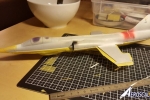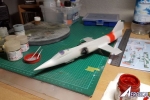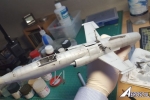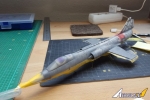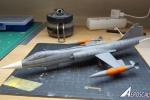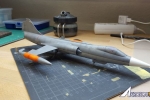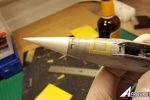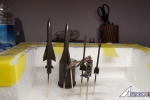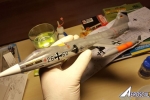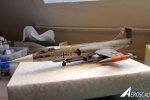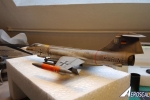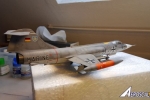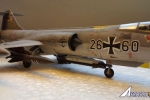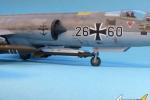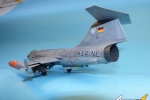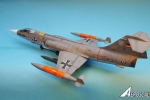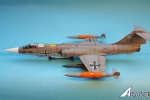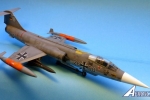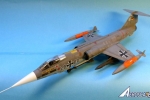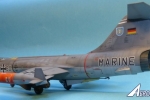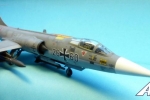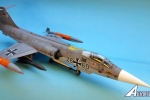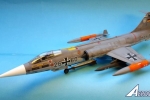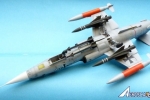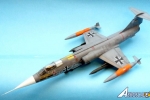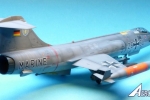1⁄1September MOM Winner: F-104
3
Comments
History
After the Luftwaffe has decided in the late 50s to replace their F-84s and F-86s with the Lockheed F-104G Starfighter the Marineflieger division more or less had no choice but also to adapt the F-104G as their main weapon system. The Marineflieger preferred in the beginning a two-engine plane like the F-4 or the Buccanneer which meant more safety when flying over the North and Baltic Sea. In total 2 Geschwader (wing) each consisting of 2 Staffeln (squadrons) flew the F-104. Marinefliegergeschwader 1 (MFG 1) was stationed in Schleswig and used the F-104 from 1963 to 1981, Marinefliegergeschwader 2 (MFG 2) in Eggebeck from 1965 to 1987.Main task of MFG 1 and MFG 2 was reconnaissance (each Geschwader had several RF-104 G for that role), anti-ship missions and ground attack. The MFG F-104Gs also defended themselves against enemy fighters with Sidewinder, usually mounted under the belly. In the very early years the F-104s were even planned for making nuclear strikes against targets in Eastern Europe. This never-liked task was abandoned in the late 60s. Only the Luftwaffegeschwader kept this role until phasing out the F-104.
During the Starfighter period the Cold War especially the Baltic Sea in northern Europe was a „hot“ place. Marineflieger F-104s met their the Warsaw Pact counterparts almost daily on their training missions. Contacts with east German, Polish and Russian MiG-21 and MiG-23 were quite common. It was common sense that if the Cold War turned hot northern Germany and Denmark's islands and shores needed to be defended against Warsaw Pact landing operations. It was assumed that the Warsaw Pact armies of the GDR and Poland would have been used to establish an additional front from the north to support a central attack in mid Germany.
MFG (R)F-104 G armament at that time consisted of
Many people still think that the F-104 was a bad plane due to its high crash rate. We now nowadays that this crash rate was not only caused by the plane alone but there have been several additional reasons:
By analyzing all those reasons and drawing the right conclusions (for example by increasing flight hours, improving safety equipment etc.) Luftwaffe and Marineflieger were able to decrease the loss rate over the decades tremendously. All people who flew with 104 or had the possibility to work with it never were mad at this plane and had only the best memories. I think it can be said that both Luftwaffe and Marineflieger made the best out of the F-104 G. 1 About the model My very first plastic model kit was a Revell F-104 G in 1/144, built in 1991 I think. This may be a reason for a deep fascination for this plane, not only in German but also in Canadian, Belgian, Italian etc. service. I always wanted to build a late Marineflieger 104 being fully armed with Kormoran and Sidewinder. Back in the 80s you could see this configuration quite often on Starfighters displayed at open days. Personally I think the Kormoran fits very well to the sleek F-104.
The kit and accessories
Danny Coremans from Belgium is a 104 nut (and I mean this 100% positive!). He created a very comprehensive kit with weapons, accessories and corrective parts for 104 1/48 kits. Inside you find things which were a few years ago nowhere available (for example recon pods for Dutch F-104s, injected moulded underwing tanks and pylons, all nuclear bombs ever used with F-104 etc.).
From this kit I used:
Also this sheet is amazing. You can depict every German F-104 possible. What I personally like are lots and lots of unique zappings which very common especially in the 80s made by ground personnel during exercises.
Construction process
Construction is straightforward. This is my 6th Hasegawa 104 kit and it went together very well without any big issues. What I persnally like with this kit each time is the great fit of the clear parts.Picture 1. Small parts and cockpit tub ready.
Picture 2. As you may see from this picture the fuselage went together well without any big issues. In this picture you can also see the Eduard canopy maskings which are highly recommendable.
Picture 3. Nose already sprayed white. I sprayed also the red engine warning line because it is easy to mask. My principle: when you can spray it easily, spray it!
Picture 4. Dayglo wingtip tank. One of the most significant characteristics of a German 104. I usually start with white, then yellow and finish with shaded orange to depict a worn-out effect.
Picture 5. Starfighter belly, already sprayed in RAL 9006 Weissaluminium (mixed by eye from Tamiya Gloss, Flat White and Aluminium. I already shaded the panel lines at that stage.
Picture 6. Ready for painting the upper side in RAL 7012 Basaltgrau.
Picture 7. Applying Basaltgrau in various brighter and darker shades.
Pictures 8 and 9. Pheeew! Being lucky, no rip off of paint when removing the masks...
Picture 10: Masking the tan coloured antenna panel on the fuselage bottom with Eduard mask
Picture 11: Missiles ready. All in typical inert weapons color of dark olive drab.
Picture 12: Applying the decals on a gloss coat.
Pictures 13 to 21 (and more): Geschafft! After applying a coat of Vallejo Matt Varnish and final assembly the F-104 is done.
Information sources
http://www.916-starfighter.de/ This great page is hosted by a former Luftaffe Starfighter and F-4 pilot. His aim is to collect and display each Starfighter used by the Bundeswehrr (916 in total) in at least one picture. But not only pictures of Luftwaffe/Marineflieger pictures can be found here.For example you can see a picture of the „real“ 26+60: http://www.916-starfighter.de/Large/2660.htm Funny thing: this was the very last Starfighter which flew for the Bundeswehr on May 21st 1991, piloted by LtCol Armin Ewert (3078 fligh hours on 104).
http://www.dacoproducts.com/ Here you find all the great stuff from DACO.
http://www.flightschwein.de/ A site hosted by a former Luftwaffe 104 mech. Great background info and pictures.
Special thanks to all Aeroscale users who voted for this model
my building buddy Rebilda who hangs around here in the forum somewhere
and finally: my wife who (still) tolerates my hobby.
Copyright ©2021 by Sebastian. Images also by copyright holder unless otherwise noted. The views and opinions expressed herein are solely the views and opinions of the authors and/or contributors to this Web site and do not necessarily represent the views and/or opinions of AeroScale, KitMaker Network, or Silver Star Enterrpises. Images also by copyright holder unless otherwise noted. Opinions expressed are those of the author(s) and not necessarily those of AeroScale. All rights reserved. Originally published on: 2016-12-02 20:30:48. Unique Reads: 8664







